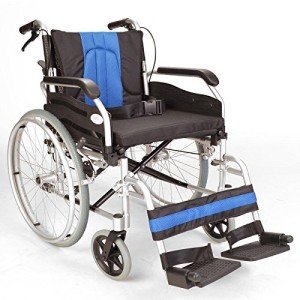Bariatric Wheelchair Seat Width
Seat Width
Having the proper seat width is essential to wheelchair users who invest longer periods in their chairs. Too narrow a seat will trigger pressure on the hips and thighs which could lead to sores or pressure points. Having too wide a seat can also make it difficult for the user to reach the hand rims to propel themselves or maneuver in little areas.
To measure the appropriate seat width an individual would rest on a chair usually and have their measurement taken throughout their lap at the largest point which is generally their hips. A wheelchair determining tape can be utilized to determine this, but a backyard stick is preferred as it avoids people from covering the tape around their hips which would provide an inaccurate result.
The standard wheelchair seat width is 16" (narrow adult), 18" (basic adult), and 20" (large adult). For bariatric patients, a 24" seat is readily available. This sturdy additional large bariatric wheelchair from Medline features swing-away footrests, a carbon steel frame with rust- and chip-resistant chrome plating, and easy-to-clean vinyl upholstery. It has a weight capacity of 500 pounds.
Seat Depth
Typically, the seat depth of a bariatric wheelchair was added 2" to the measurement taken at the user's widest point (normally their hips). This was meant to accommodate additional layers of clothing that may be used throughout cold weather. Nevertheless, this practice is becoming less typical as wheelchair users have the ability to spend more time inside your home and are not using long coats. This makes the seat depth of a chair lesser when choosing a bariatric wheelchair. Nevertheless, it is still crucial to choose an option that offers appropriate support for bigger users.
The Medline folding additional wide bariatric manual wheelchair features a comfortable 24" seat width and a heavy-duty slide tube silver vein frame. It likewise has an adjustable axle and tool-free elevating legrests.
Seat Height
When it concerns determining the proper wheelchair seat width you should always measure from the user's largest point which is usually their hips. You will also need to consider whether the user is going to be using a winter season coat as this might add 2" to the width required.

When My Mobility Scooters remains in usage it ought to only be operated on level surfaces with the wheel locks completely engaged. This is to prevent the chair from being able to move slopes that are 10 degrees or higher. It is likewise essential to remember that any activity that might move the center of mass in the chair ought to be made with care. This includes grabbing items that require the individual to lean out of their seat or trying to stand up from it.
Whenever you have the chair in usage it is suggested that you regularly check it for damage and oil any areas that are considered necessary. For example, the casters ought to be lubricated by eliminating the caster fork and using a multi-purpose grease to use to the caster stem bearings. Similarly, the foot plates can be adjusted by loosening up the bolt and then moving them to the wanted position. This allows the feet to sit comfortably on the footplate and prevents any pressure points from forming. This can be extremely unpleasant for the user and if left unattended, can cause push sores.
Weight Capacity
Bariatric wheelchairs are designed to support more weight than basic wheelchairs. This makes them sturdier and much better geared up to deal with falls. They are likewise normally larger and wider, making them less maneuverable in tight areas than basic wheelchairs. They require automobiles with unique ramps and lifts to pack them, as well as motorists who understand how to best transport them from one location to the next.
When selecting a wheelchair, consider its weight capacity as it will be the primary determining factor in whether it will accommodate your guest's requirements. The weight capacity of the chair is frequently listed as a fixed load, meaning that it indicates the amount of weight the chair can conveniently hold while standing still. However, some makers likewise note an active load that is based upon a drop test and can simulate the result of somebody taking a seat in the chair. This might be a more trustworthy measurement of the weight limit, depending upon your requirements.
If you prepare to carry out activities that move your center of gravity in the seat (such as reaching for things), be sure to have front casters pointed in a forward instructions and wheel locks engaged so the chair will not tip over. Also, inspect that casters are lubricated regularly to avoid extreme wear and abrasions. The lubrication procedure involves getting rid of the fork, separating the caster from the wheel, and greasing the caster stem bearings with high-quality multi-purpose grease.
